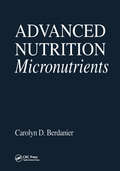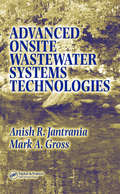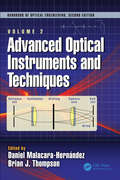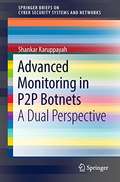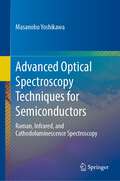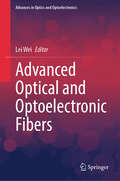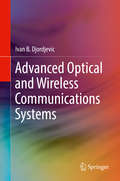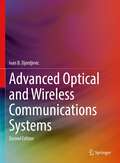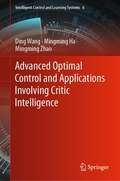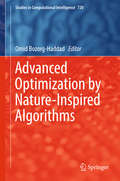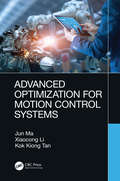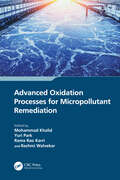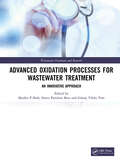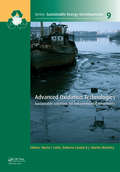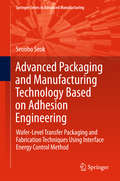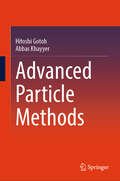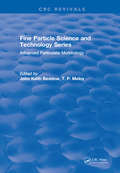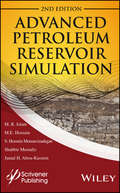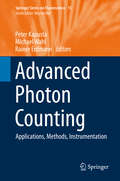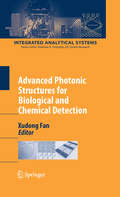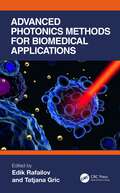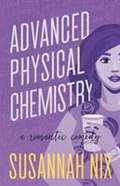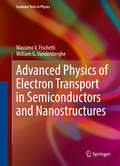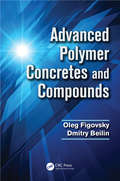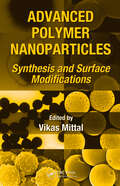- Table View
- List View
Advanced Nutrition Micronutrients: Macronutrients, Micronutrients, And Metabolism, Second Edition (Modern Nutrition Ser.)
by Carolyn D. BerdanierAdvanced Nutrition: Micronutrients, a continuation of the first Advanced Nutrition text on macronutrients, focuses on how vitamins and minerals operate at the genomic level. It reflects the major research endeavors by nutrition scientists throughout the world in studying nutrient-gene, nutrient-nutrient, and nutrient-drug interactions. The book is
Advanced Onsite Wastewater Systems Technologies
by Anish R. Jantrania Mark A. GrossDrawing on the authors' combined experience of more than 30 years, Advanced Onsite Wastewater Systems Technologies explores use of these technologies on a wide-scale basis to solve the problems associated with conventional septic tank and drain field systems. The authors discuss a regulatory and management infrastructure for ensuring long-term, rel
Advanced Optical Instruments and Techniques (Optical Science and Engineering #2)
by Daniel Malacara-Hernández Brian J. ThompsonAdvanced Optical Instruments and Techniques includes twenty-three chapters providing processes, methods, and procedures of cutting-edge optics engineering design and instrumentation. Topics include biomedical instrumentation and basic and advanced interferometry. Optical metrology is discussed, including point and full-field methods. Active and adaptive optics, holography, radiometry, the human eye, and visible light are covered as well as materials, including photonics, nanophotonics, anisotropic materials, and metamaterials.
Advanced Optical Methods for Brain Imaging (Progress In Optical Science And Photonics #5)
by Gerd Keiser Fu-Jen Kao Ankur GogoiCompiles topics starting from the basics of neuroscience to the most recent advances in structural and functional brain imaging technologies.<P><P> Presents focused and comprehensive description of the physical principles, instrumentation, and the most recent brain imaging applications using optical methods.<P> Addresses the development of novel techniques like adaptive optics, click chemistry reactions, artificial neural networks, and the CLARITY method in the field of brain imaging.<P> This book highlights the rapidly developing field of advanced optical methods for structural and functional brain imaging. As is known, the brain is the most poorly understood organ of a living body. It is indeed the most complex structure in the known universe and, thus, mapping of the brain has become one of the most exciting frontlines of contemporary research. Starting from the fundamentals of the brain, neurons and synapses, this book presents a streamlined and focused coverage of the core principles, theoretical and experimental approaches, and state-of-the-art applications of most of the currently used imaging methods in brain research. It presents contributions from international leaders on different photonics-based brain imaging modalities and techniques. Included are comprehensive descriptions of many of the technology driven spectacular advances made over the past few years that have allowed novel insights of the structural and functional details of neurons.<P> The book is targeted at researchers, engineers and scientists who are working in the field of brain imaging, neuroscience and connectomics. Although this book is not intended to serve as a textbook, it will appeal to undergraduate students engaged in the specialization of brain imaging.
Advanced Optical Spectroscopy Techniques for Semiconductors: Raman, Infrared, and Cathodoluminescence Spectroscopy
by Masanobu YoshikawaThis book focuses on advanced optical spectroscopy techniques for the characterization of cutting-edge semiconductor materials. It covers a wide range of techniques such as Raman, infrared, photoluminescence, and cathodoluminescence (CL) spectroscopy, including an introduction to their physical fundamentals and best operating principles. Aimed at professionals working in the research and development of semiconductors and semiconductor materials, this book looks at a broad class of materials such as silicon and silicon dioxide, nano-diamond thin films, quantum dots, and gallium oxide. In addition to the spectroscopic techniques covered, this book features a chapter devoted to the use of a scanning electron transmission microscope as an excitation source for CL spectroscopy. Written by a practicing industry expert in the field, this book is an ideal source of reference and best-practices guide for physicists, as well as materials scientists and engineers involved in the area of spectroscopy of semiconductor materials. Further, this book introduces the cutting-edge spectroscopy such as optical photothermal IR and Raman spectroscopy or terahertz time-domain spectroscopy (THz-TDS) etc.
Advanced Optical and Optoelectronic Fibers (Advances in Optics and Optoelectronics)
by Lei WeiThis book highlights the recent scientific and technological innovations of various optical and optoelectronic fibers based on different functional structures and materials. Advanced optical and optoelectronic fibers locate at the intersection of many disciplines ranging from optical waveguides, optoelectronics, material engineering, micro/nanofabrication, and neural interfaces to wearable devices. The book covers the major developments on fiber materials, such as semiconductors, metals, polymers, and soft glasses, as well as novel in-fiber structures. Different functionalities are also summarized, including sensing, light guidance, lasing, and material engineering toward full system integration. The book is a valuable resource for researchers, engineers, and graduate students engaged in the study of optical and optoelectronic fibers.
Advanced Optical and Wireless Communications Systems
by Ivan B. DjordjevicThis textbook introduces the advanced topics of: (i) wireless communications, (ii) free-space optical (FSO) communications, (iii) indoor optical wireless (IR) communications, and (iv) fiber-optics communications and presents these different types of communication systems in a unified fashion for better practical use. Fundamental concepts, such as propagation principles, modulation formats, channel coding, diversity principles, MIMO signal processing, multicarrier modulation, equalization, adaptive modulation and coding, detection principles, and software defined transmission are first described and then followed up with a detailed look at each particular system. The book is self-contained and structured to provide straightforward guidance to readers looking to capture fundamentals and gain theoretical and practical knowledge about wireless communications, optical communications, and fiber-optics communications, all which can be readily applied in studies, research, and practical applications. The textbook is intended for an upper undergraduate or graduate level course in optical communication. It features problems, an appendix with all background material needed, and homework.
Advanced Optical and Wireless Communications Systems
by Ivan B. DjordjevicThe new edition of this popular textbook keeps its structure, introducing the advanced topics of: (i) wireless communications, (ii) free-space optical (FSO) communications, (iii) indoor optical wireless (IR) communications, and (iv) fiber-optics communications, but thoroughly updates the content for new technologies and practical applications. The author presents fundamental concepts, such as propagation principles, modulation formats, channel coding, diversity principles, MIMO signal processing, multicarrier modulation, equalization, adaptive modulation and coding, detection principles, and software defined transmission, first describing them and then following up with a detailed look at each particular system. The book is self-contained and structured to provide straightforward guidance to readers looking to capture fundamentals and gain theoretical and practical knowledge about wireless communications, free-space optical communications, and fiber-optics communications, all which can be readily applied in studies, research, and practical applications. The textbook is intended for an upper undergraduate or graduate level courses in fiber-optics communication, wireless communication, and free-space optical communication problems, an appendix with all background material needed, and homework problems. In the second edition, in addition to the existing chapters being updated and problems being inserted, one new chapter has been added, related to the physical-layer security thus covering both security and reliability issues. New material on 5G and 6G technologies has been added in corresponding chapters.
Advanced Optimal Control and Applications Involving Critic Intelligence (Intelligent Control and Learning Systems #6)
by Ding Wang Mingming Zhao Mingming HaThis book intends to report new optimal control results with critic intelligence for complex discrete-time systems, which covers the novel control theory, advanced control methods, and typical applications for wastewater treatment systems. Therein, combining with artificial intelligence techniques, such as neural networks and reinforcement learning, the novel intelligent critic control theory as well as a series of advanced optimal regulation and trajectory tracking strategies are established for discrete-time nonlinear systems, followed by application verifications to complex wastewater treatment processes. Consequently, developing such kind of critic intelligence approaches is of great significance for nonlinear optimization and wastewater recycling. The book is likely to be of interest to researchers and practitioners as well as graduate students in automation, computer science, and process industry who wish to learn core principles, methods, algorithms, and applications in the field of intelligent optimal control. It is beneficial to promote the development of intelligent optimal control approaches and the construction of high-level intelligent systems.
Advanced Optimization by Nature-Inspired Algorithms (Studies in Computational Intelligence #720)
by Omid Bozorg-HaddadThis book, compiles, presents, and explains the most important meta-heuristic and evolutionary optimization algorithms whose successful performance has been proven in different fields of engineering, and it includes application of these algorithms to important engineering optimization problems. In addition, this book guides readers to studies that have implemented these algorithms by providing a literature review on developments and applications of each algorithm. This book is intended for students, but can be used by researchers and professionals in the area of engineering optimization.
Advanced Optimization for Motion Control Systems
by Jun Ma Kok Kiong Tan Xiaocong LiPrecision motion control is strongly required in many fields, such as precision engineering, micromanufacturing, biotechnology, and nanotechnology. Although great achievements have been made in control engineering, it is still challenging to fulfill the desired performance for precision motion control systems. Substantial works have been presented to reveal an increasing trend to apply optimization approaches in precision engineering to obtain the control system parameters. In this book, we present a result of several years of work in the area of advanced optimization for motion control systems. The book is organized into two parts: Part I focuses on the model-based approaches, and Part II presents the data-based approaches. To illustrate the practical appeal of the proposed optimization techniques, theoretical results are verified with practical examples in each chapter. Industrial problems explored in the book are formulated systematically with necessary analysis of the control system synthesis. By virtue of the design and implementation nature, this book can be used as a reference for engineers, researchers, and students who want to utilize control theories to solve the practical control problems. As the methodologies have extensive applicability in many control engineering problems, the research results in the field of optimization can be applied to full-fledged industrial processes, filling in the gap between research and application to achieve a technology frontier increment.
Advanced Oxidation Processes for Micropollutant Remediation
by Mohammad Khalid Rashmi Walvekar Rama Rao Karri Yuri ParkAdvanced Oxidation Processes for Micropollutant Remediation covers current state-of-the-art in advanced oxidation processes (AOP) for removal of micropollutants from industrial and pharmaceutical wastewater. It covers various AOP-based techniques like Fenton process, ozonation, hydrogen peroxide, ultraviolet radiation, electrochemical oxidation, ultrasonic irradiation, and other hybrid technologies. It focuses on aspects like impact of micropollutants on the ecosystems, different types of AOPs, their principles, applications, and challenges in implementing these techniques and their future perspectives. Features: Presents state-of-the-art in advanced oxidation processes (AOP) techniques along with hybrid technologies. Covers latest advances in technological know-how for remediation of wastewater soiled with micropollutants. Discusses pressing environmental pollution issues associated with AOPs needed for wastewater remediation. Presents future perspective as well as techno-economic analysis in implementing various AOPs. Reviews strategies to limit the micropollutants in water bodies. This book is aimed at graduate students and researchers in chemical and industrial engineering, environmental science, and wastewater treatment.
Advanced Oxidation Processes for Wastewater Treatment: An Innovative Approach (Wastewater Treatment and Research)
by Maulin P. Shah Sweta Parimita Bera Günay Yıldız TöreAdvanced Oxidation Processes for Wastewater Treatment: An Innovative Approach: This book highlights the importance of various innovative advanced oxidation technology to clean up the environment from pollution caused by human activities. It assesses the potential application of several existing bioremediation techniques and introduces new emerging technologies. This book is an updated vision of the existing advanced oxidation strategies with their limitations and challenges and their potential application to remove environmental pollutants. It also introduces the new trends and advances in environmental bioremediation technology with thorough discussion of recent developments in this field. This book highlights the importance of different innovative advanced oxidation process to deal with the ever-increasing number of environmental pollutants. Features: Illustrates the importance of various advance oxidation processes in effluent treatment plant Points out the reuse of the treated wastewater through emerging advance oxidation technologies for effluent treatment plant Highlights the recovery of resources from wastewater Pays attention to the occurrence of novel micro-pollutants Emphasizes the role of nanotechnology in bioremediation of pollutants Introduces new trends in environmental bioremediation
Advanced Oxidation Technologies: Sustainable Solutions for Environmental Treatments (Sustainable Energy Developments)
by Marta I. Litter Roberto J. Candal J. Martín MeichtryAdvanced Oxidation Technologies (AOTs) or Processes (AOPs) are relatively new and innovative technologies to remove harmful and toxic pollutants. The most important processes among them are those using light, such as UVC/H2O2, photo-Fenton and heterogeneous photocatalysis with TiO2. These technologies are also relatively low-cost and therefore usef
Advanced Packaging and Manufacturing Technology Based on Adhesion Engineering: Wafer-level Transfer Packaging And Fabrication Techniques Using Interface Energy Control Method (Springer Series in Advanced Manufacturing)
by Seonho SeokThis book introduces microelectromechanical systems (MEMS) packaging utilizing polymers or thin films – a new and unique packaging technology. It first investigates the relationship between applied load and opening displacement as a function of benzocyclobutene (BCB) cap size to find the debonding behavior, and then presents BCB cap deformation and stress development at different opening displacements as a function of BCB thickness, which is a criterion for BCB cap transfer failure.
Advanced Particle Methods
by Hitoshi Gotoh Abbas KhayyerThis book provides an in-depth, comprehensive, and comprehensible description of the theoretical background and numerical methodologies corresponding to advanced particle methods formulated in classical Newtonian mechanics for simulation of fluids, structures, and their interactions. Particle methods are regarded as new-generation computational technology with a broad range of applications in engineering and science. Advanced particle methods refer to the latest developed particle methods with high stability, accuracy, conservation, and convergence properties. Distinctively, the described advanced particle methods are characterized by a clear, consistent mathematical–physical background, the absence of artificial numerical stabilizers that often require parameter tuning, rigorous satisfaction of boundary conditions, and excellent numerical results that have been extensively and scrupulously verified with respect to reliable analytical and experimental reference solutions. This book presents a unified description for both smoothed particle hydrodynamics (SPH) and moving particle semi-implicit (MPS) methods through a coherent presentation of fundamental equations, and numerical algorithms and schemes. Special attention is devoted to meticulous and coherent explanation of the advanced particle methods such that even undergraduate students can follow the derivation process and thoroughly understand the concepts and equations. The state-of-the-art particle method technology is also portrayed with the presentation of developed multi-physics, multi-scale particle methods corresponding to multi-phase flows, and hydroelastic fluid–structure interactions with rigorous treatment of interfacial moving boundaries.
Advanced Particulate Morphology
by John Keith BeddowThis volume, based on the 1977 NSF Residential Advanced Particle Morphology Workshop, covers the principle developments in this new and rapidly evolving field. The divergent fields of interst of the authors reflect the prosepcts for the wide application of particle morphology analysis and include: many branches of science and engineering concerned with fine particles, information processing, life sciences, pharmacy, and food technology.
Advanced Petroleum Reservoir Simulation: Towards Developing Reservoir Emulators
by M. R. Islam M. E. Hossain S. Hossien Mousavizadegan Jamal H. Abou-Kassem Shabbir MustafizThis second edition of the original volume adds significant new innovations for revolutionizing the processes and methods used in petroleum reservoir simulations. With the advent of shale drilling, hydraulic fracturing, and underbalanced drilling has come a virtual renaissance of scientific methodologies in the oil and gas industry. New ways of thinking are being pioneered, and Dr. Islam and his team have, for years now, been at the forefront of these important changes. This book clarifies the underlying mathematics and physics behind reservoir simulation and makes it easy to have a range of simulation results along with their respective probability. This makes the risk analysis based on knowledge rather than guess work. The book offers by far the strongest tool for engineers and managers to back up reservoir simulation predictions with real science. The book adds transparency and ease to the process of reservoir simulation in way never witnessed before. Finally, No other book provides readers complete access to the 3D, 3-phase reservoir simulation software that is available with this text. A must-have for any reservoir engineer or petroleum engineer working upstream, whether in exploration, drilling, or production, this text is also a valuable textbook for advanced students and graduate students in petroleum or chemical engineering departments.
Advanced Photon Counting: Applications, Methods, Instrumentation (Springer Series on Fluorescence #15)
by Peter Kapusta Michael Wahl Rainer ErdmannThis volume focuses on Time-Correlated Single Photon Counting (TCSPC), a powerful tool allowing luminescence lifetime measurements to be made with high temporal resolution, even on single molecules. Combining spectrum and lifetime provides a "fingerprint" for identifying such molecules in the presence of a background. Used together with confocal detection, this permits single-molecule spectroscopy and microscopy in addition to ensemble measurements, opening up an enormous range of hot life science applications such as fluorescence lifetime imaging (FLIM) and measurement of Förster Resonant Energy Transfer (FRET) for the investigation of protein folding and interaction. Several technology-related chapters present both the basics and current state-of-the-art, in particular of TCSPC electronics, photon detectors and lasers. The remaining chapters cover a broad range of applications and methodologies for experiments and data analysis, including the life sciences, defect centers in diamonds, super-resolution microscopy, and optical tomography. The chapters detailing new options arising from the combination of classic TCSPC and fluorescence lifetime with methods based on intensity fluctuation represent a particularly unique highlight.
Advanced Photonic Structures for Biological and Chemical Detection (Integrated Analytical Systems)
by Xudong FanThis book is a part of Books Series on Integrated Microanalytical Systems. It discusses the latest applications of photonic technologies in bio-chemical sensing. Based on the photonic structures, the book is divided into four sections: Photonic crystal structures; Optical microring resonator structures; Optical fiber/waveguide structures; and, Miscellaneous or hybrid structures.
Advanced Photonics Methods for Biomedical Applications
by Tatjana Gric Edik RafailovAdvanced photonics methods for biomedical applications give researchers in universities and industries, and clinicians an overview of the novel tools for cancer diagnostics and treatment. This book provides researchers and professionals in the area of biomedical photonics with a toolbox of novel methodologies for biomedical applications, including health diagnostics, cancer detection, and treatment. It covers the theory, modeling, and design of each method, alongside their applications, fabrication, characterization, and measurements in clinical practice. A wide scope of concepts concerning innovative science and technologies of medicine will be covered, providing the readers with the latest research, developments, and technologies. It will also be a valuable resource for students and early-career researchers, alongside those involved in the design of the novel photonics-based techniques for health diagnostics and cancer detection and treatment. Key features • Discusses novel methods of cancer diagnostics and cancer treatment. • Details non and minimally invasive photonics techniques. • Explores the applications of machine learning and artificial intelligence to these novel techniques.
Advanced Physical Chemistry: A Romantic Comedy
by Susannah Nix<p>After four lousy boyfriends in a row, chemical engineer Penny Popplestone swears off men until she can figure out why they keep cheating on her. But her no-men resolution hits a snag when the mysterious and superhumanly hot barista at her favorite coffee shop strikes up a friendship with her. <p>Penny strives to keep things platonic, but when Caleb gives her the kiss of her life, she realizes he wants to be more than just friends. Tired of always being "good little Penny," she throws caution to the wind and pursues a no-strings fling with the hottie barista. It's not like they have anything in common beyond scorching physical chemistry, so what does she have to lose? <p>Only her heart. <p>Now, this fanfic-reading, plus-size heroine faces an unsolvable problem. What do you do when being apart is unbearable...but being together is impossible? <p>Advanced Physical Chemistry is the third in a series of standalone rom-coms featuring geeky heroines who work in STEM fields.</p>
Advanced Physics of Electron Transport in Semiconductors and Nanostructures: Electronic Properties And Transport (Graduate Texts in Physics)
by Massimo V. Fischetti William G. VandenbergheThis textbook is aimed at second-year graduate students in Physics, Electrical Engineering, or Materials Science. It presents a rigorous introduction to electronic transport in solids, especially at the nanometer scale. Understanding electronic transport in solids requires some basic knowledge of Hamiltonian Classical Mechanics, Quantum Mechanics, Condensed Matter Theory, and Statistical Mechanics. Hence, this book discusses those sub-topics which are required to deal with electronic transport in a single, self-contained course. This will be useful for students who intend to work in academia or the nano/ micro-electronics industry. Further topics covered include: the theory of energy bands in crystals, of second quantization and elementary excitations in solids, of the dielectric properties of semiconductors with an emphasis on dielectric screening and coupled interfacial modes, of electron scattering with phonons, plasmons, electrons and photons, of the derivation of transport equations in semiconductors and semiconductor nanostructures somewhat at the quantum level, but mainly at the semi-classical level. The text presents examples relevant to current research, thus not only about Si, but also about III-V compound semiconductors, nanowires, graphene and graphene nanoribbons. In particular, the text gives major emphasis to plane-wave methods applied to the electronic structure of solids, both DFT and empirical pseudopotentials, always paying attention to their effects on electronic transport and its numerical treatment. The core of the text is electronic transport, with ample discussions of the transport equations derived both in the quantum picture (the Liouville-von Neumann equation) and semi-classically (the Boltzmann transport equation, BTE). An advanced chapter, Chapter 18, is strictly related to the 'tricky' transition from the time-reversible Liouville-von Neumann equation to the time-irreversible Green's functions, to the density-matrix formalism and, classically, to the Boltzmann transport equation. Finally, several methods for solving the BTE are also reviewed, including the method of moments, iterative methods, direct matrix inversion, Cellular Automata and Monte Carlo. Four appendices complete the text.
Advanced Polymer Concretes and Compounds
by Oleg Figovsky Dmitry BeilinOne way of improving performance attributes of building structures is to use a new class of materials-polymer composites. They have unique properties that combine high strength with features of non-metallic materials. Polymer concretes (PC) appear to offer many possibilities for producing new materials with desired physical and mechanical character
Advanced Polymer Nanoparticles: Synthesis and Surface Modifications
by Vikas MittalPolymer latex particles continue to become increasingly important in numerous commercial applications. Advanced synthesis techniques are the key to developing new functionality for nanoparticles. These methods make it possible to tailor the size, chemical composition, or properties of these particles, as well as the molecular weight of the polymer
